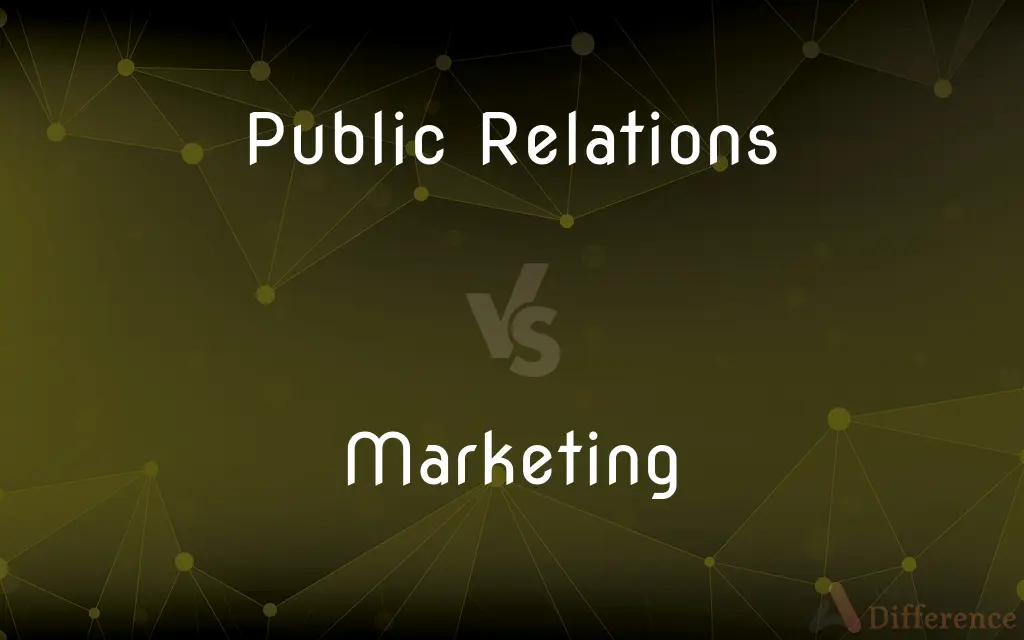Public Relations vs. Marketing — What's the Difference?
Edited by Tayyaba Rehman — By Fiza Rafique — Published on January 12, 2024
Public Relations (PR) focuses on managing a company's image and relationships with the public. Marketing concentrates on promoting and selling products or services.

Difference Between Public Relations and Marketing
Table of Contents
ADVERTISEMENT
Key Differences
Public Relations, often abbreviated as PR, primarily centers on cultivating and maintaining a positive image for a company or individual. Its essence is about shaping perceptions, building goodwill, and fostering trust among various stakeholders, including the public, media, and investors.
In contrast, Marketing delves into the strategies and tactics used to identify, create, and keep satisfied customers. Its emphasis is on understanding consumer needs, creating value propositions, and communicating these to the target audience to drive sales and growth.
A key distinction between Public Relations and Marketing is their primary goals. PR seeks to create and uphold a favorable public image, often without a direct intention of sales. For instance, handling a crisis, building relationships with journalists, or arranging community outreach are quintessential PR activities.
Marketing, on the other hand, is typically more revenue-driven. It encompasses activities like advertising, product launches, and promotions, all designed to increase market share and profits. While PR might indirectly influence sales through positive perception, Marketing directly aims for conversions.
It's also worth noting that while Public Relations and Marketing have distinct objectives, they are not mutually exclusive. In fact, they often overlap and collaborate. A positive public image (achieved through PR) can bolster marketing efforts, while strategic marketing can enhance public perception.
ADVERTISEMENT
Comparison Chart
Primary Objective
Managing and enhancing company's public image.
Promoting and selling products or services.
Approach
Strategic and relationship-based.
Tactical with a focus on consumer needs.
Tools
Press releases, media relations, crisis management.
Advertising, promotions, market research.
Measurement of Success
Positive media coverage, stakeholder relationships.
Sales figures, market share, customer retention.
Interaction with Target Audience
Indirect, through media and public interactions.
Direct, through advertisements and promotions.
Compare with Definitions
Public Relations
Management of information from an organization to the public.
Their Public Relations strategy kept shareholders informed during the merger.
Marketing
Identifying and meeting consumer needs profitably.
The company's Marketing department researched trends before launching the product.
Public Relations
The practice of managing the communication between an organization and its public.
The company's Public Relations team swiftly addressed the recent controversy.
Marketing
The business process of promoting and selling products or services.
Their aggressive Marketing strategy resulted in impressive sales figures.
Public Relations
A strategic communication process building mutually beneficial relationships.
Effective Public Relations has helped the brand earn consumers' trust.
Marketing
Combination of tactics used to generate demand and interest in products.
Their guerrilla Marketing tactics garnered a lot of attention at the event.
Public Relations
Handling of an organization's image and reputation.
The Public Relations campaign after the mishap restored the company's image.
Marketing
Activities aimed at presenting products to potential customers.
Digital Marketing has taken precedence in the modern business environment.
Public Relations
Building and sustaining a positive public image for organizations or individuals.
Celebrity Public Relations often involves managing perceptions and media interactions.
Marketing
The strategic mix of advertising, sales promotion, and public relations to reach consumers.
The Marketing mix was adjusted based on feedback, leading to increased sales.
Public Relations
Public relations in attributive use
Marketing
The act or process of buying and selling in a market.
Marketing
The strategic functions involved in identifying and appealing to particular groups of consumers, often including activities such as advertising, branding, pricing, and sales.
Marketing
Present participle of market
Marketing
Buying and/or selling in a market (street market or market fair).
Marketing
Shopping, going to market as a buyer.
Marketing
(dated) Attending market as a seller.
Marketing was a time-consuming task for truck farming families, as the round trip could take most of the day.
Marketing
(uncountable) The promotion, distribution and selling of a product or service; the work of a marketer; includes market research and advertising.
A bachelor's degree in marketing
Marketing
The act of selling or of purchasing in, or as in, a market.
Marketing
Articles in, or from, a market; supplies.
Marketing
The activities required by a producer to sell his products, including advertising, storing, taking orders, and distribution to vendors or individuals.
Marketing
The exchange of goods for an agreed sum of money
Marketing
The commercial processes involved in promoting and selling and distributing a product or service;
Most companies have a manager in charge of marketing
Marketing
Shopping at a market;
Does the weekly marketing at the supermarket
Common Curiosities
How do Public Relations and Marketing differ in their objectives?
Public Relations aims to manage a company's public image, while Marketing focuses on promoting and selling products or services.
Are Public Relations and Marketing interrelated?
Yes, they often overlap and can bolster each other's efforts in building a brand's image and driving sales.
Can a company survive with just Marketing and no Public Relations?
While possible, a strong Public Relations strategy can enhance Marketing efforts by maintaining a positive brand image.
Why might a company need a Public Relations team during a crisis?
A Public Relations team can manage communication, shape narratives, and protect the company's reputation during crises.
Is advertising a part of Marketing or Public Relations?
Advertising is primarily a component of Marketing, aiming to promote products or services directly to consumers.
What tools are commonly used in Marketing?
Marketing employs tools like advertising, promotions, market research, and product positioning.
How do companies measure the success of their Public Relations campaigns?
Success in Public Relations can be gauged by positive media coverage, effective crisis management, and strong stakeholder relationships.
Why do some products have marketing campaigns but no apparent Public Relations efforts?
While both are important, some brands prioritize direct sales efforts and might invest more heavily in Marketing.
How do Public Relations professionals manage negative publicity?
They may use strategies like issuing public statements, engaging with media, organizing interviews, or initiating corrective actions.
Can Public Relations influence sales?
Indirectly, yes. A positive public image can lead to increased trust and favorability, which can influence purchasing decisions.
Share Your Discovery

Previous Comparison
NBC vs. CNBC
Next Comparison
Plants vs. AnimalsAuthor Spotlight
Written by
Fiza RafiqueFiza Rafique is a skilled content writer at AskDifference.com, where she meticulously refines and enhances written pieces. Drawing from her vast editorial expertise, Fiza ensures clarity, accuracy, and precision in every article. Passionate about language, she continually seeks to elevate the quality of content for readers worldwide.
Edited by
Tayyaba RehmanTayyaba Rehman is a distinguished writer, currently serving as a primary contributor to askdifference.com. As a researcher in semantics and etymology, Tayyaba's passion for the complexity of languages and their distinctions has found a perfect home on the platform. Tayyaba delves into the intricacies of language, distinguishing between commonly confused words and phrases, thereby providing clarity for readers worldwide.
















































